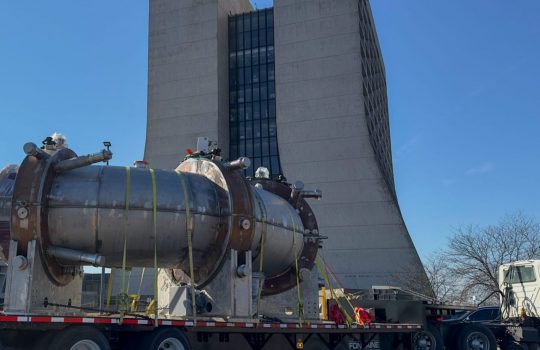Batavia, IL-Scientists of the Pierre Auger Project, whose goal is to discover the source of very high-energy cosmic rays, will announce the choice of the project’s northern-hemisphere observatory at a meeting in San Rafael, Argentina on September 12. The 150-member collaboration will choose among three sites: one in western Spain, one in the western U.S., and one in Mexico.
At the chosen site, the collaboration will build a Rhode-Island-sized detector array to observe the air showers from mysterious high-energy cosmic rays that zoom to earth from an unknown source in space. In November, 1995, the Auger Project chose a site near Mendoza, Argentina, to build a similar southern-hemisphere observatory.
Cosmic rays are fast-moving particles from space that constantly bombard the earth from all directions. These particles, usually protons, strike air molecules in the atmosphere, creating cascades of secondary particles, called air showers. The Auger Project takes its name from the discoverer of extensive air showers, French physicist Pierre Auger, who first observed the phenomenon in 1938. Scientific theory can account for the sources of low- and medium-energy cosmic rays that strike the earth, but the origin of the rare high-energy cosmic rays remains a mystery-one that Auger collaborators hope to solve.
The Auger Project’s two observatories will measure the nature, energy and direction of these high-energy cosmic rays-the most energetic particles in nature, with more than 100 million times the energy of particles produced by the most powerful particle accelerators on earth. Each Auger observatory will contain 1,600 particle detectors, special 3000-gallon water tanks spaced 1.5 kilometers apart over an area of 3,000 square kilometers. An optical fluorescence or “fly’s eye” detector will sit at the center of each array. The Auger Project hopes to begin cosmic ray observations early in the next century. Collaborators estimate the cost of constructing the observatories at approximately $100 million.
The collaboration includes scientists from 40 institutions in 19 countries. Funding for development of the Auger Project comes from the United Nations Educational, Scientific, and Cultural Organization and science agencies of participating nations. It includes scientists from Argentina, Armenia, Australia, Bolivia, Brazil, Chile, the Peoples Republic of China, France, Georgia, Germany, Greece, Japan, Mexico, Russia, Slovenia, Spain, the United Kingdom, the United States, and Vietnam.
###
Note to editors:
The Office of Public Affairs at Fermi National Accelerator Laboratory, a collaborating institution in the Auger Project, will issue a release on September 12, announcing the choice of the collaboration’s northern-hemisphere site. Fermilab’s Office of Public Affairs will direct media inquiries to Auger collaborators at the collaboration meeting in Argentina. For photos and a package of background material on the Auger Project, call (630-840-3351) or email (topquark@fnal.gov) the Fermilab Office of Public Affairs.



